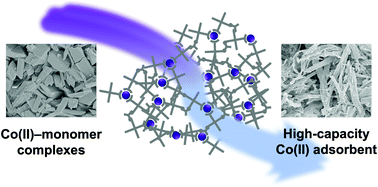Templated synthesis enhances the cobalt adsorption capacity of a porous organic polymer†
Abstract
Divalent transition metals such as Co(II) are important targets for removal from water sources, due to their potential toxicity as well as their high value. In this study, we found that a series of porous organic polymers based on amide-linked tetraphenylmethane units are effective Co(II) ion adsorbents in aqueous solution. To increase the density of Co(II) binding sites, we then developed a templated synthesis in which the branched, rigid monomers are pre-assembled around Co(II) ions prior to polymerization. After polymer formation, the Co(II) template ions are removed to yield a material rich in Co(II) binding sites. Ion adsorption isotherms show that the Co(II)-templated material has an ion adsorption capacity significantly greater than those of the non-templated materials, highlighting the utility of a templated synthetic route. SEM and TEM images show the morphology of the templated polymer to be dramatically different from the non-templated polymers and to be similar in size and shape to the Co(II)–monomer precursors, emphasizing the role of the template ions in directing the formation of the resulting polymer. This guest-templated approach requires no functionalization of the generic monomer and represents a promising synthetic route to high-capacity ion adsorbents for water purification and aqueous separations.

- This article is part of the themed collections: Celebrating International Women’s Day: Women in Nanoscience and Nanoscale 2022 Emerging Investigators


 Please wait while we load your content...
Please wait while we load your content...